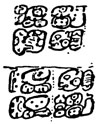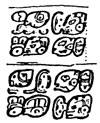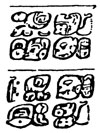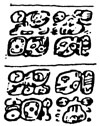
 |
THE FOUNDATION RESEARCH DEPARTMENT | |||
A Grammar of the Yucatecan Mayan Language Dresden Codex, Pages 29c - 31c and The Book of Chilam Balam of Chumayel In reading through the various Yucatecan Mayan colonial books, in particular those called the "Books of Chilam Balam", one finds such phrases as "lay bin u hokzah tu uooh anahte bin" (thus it was said that he took it (that is, the passage in which this line appears) out of the hieroglyphs of the book) (Bolles 1983, line C435), "tin hokzah ti uooh" (I took this out of the hieroglyphs) (Bolles 1983, line C560), and "ca ix u xocahoob tu uoohil" (and thus they read it in the hieroglyphs) (Bolles 1983, line J431). It would thus seem to be a reasonable assumption that the person or persons who originally wrote the Yucatecan Mayan colonial texts from which the various "Books of Chilam Balam" were formed were able to read hieroglyphs and in fact were often transcribing hieroglyphic texts when writing down the material in Latin script. Some researchers have made contributions with this assumption in mind. Maria Cristina Alvarez, in her 1974 monograph "Textos Coloniales del Libro de Chilam Balam de Chumayel y Textos Glificos del Codice de Dresde", wrote about the relationship between pages 30c-31c of the Dresden Codex and the opening passages from the first page of the Book of Chilam Balam of Chumayel. The material from the Chumayel is divided into two parts, called here rituals. Ritual 1 (Bolles 1983, lines H001-H006) gives the names of the founders of the Canul, Cauich, Noh, and Pucte linages. From the folio numbering it is clear that the first folio of the Chumayel is missing. Since it seems evident that this ritual was already begun on the now missing folio, the founder's name for the Canul linage is actually not given but has been lost with the loss of the first folio. Note that there is a difference of opinion between Alvarez and myself on how the actual phrasing should be. Generally a phrase such as "u chun u uinicil" (the beginning of the people (i.e. linage)) should be preceded by a subject just as it is followed by an object as shown by Alvarez. I have therefore shown subjects for these phrases as allowed for by the original text, and go on the assumption that the subject for the first phrase has been lost with the missing folio 1. Ritual 2 (Bolles 1983, lines H008-H039) lists the attributes of "ah muzen cab" (a deity of the bees) in his four aspects, each one with its world direction and corresponding world direction color. In editing this ritual I have made the assumption that each article mentioned (i.e. "che", "iz", "ulum", etc.) should be mentioned in each paragraph for a world direction. Maria Cristina Alvarez (1974) believes Rituals 1 and 2 to be related to Codex Dresden, pages 30c-31c. In fact, as can be seen from the accompanying comparison of Ritual 2 with pages 29c-31c of the Codex Dresden, if Alvarez's assertion is correct there seems reason to think that Dresden 29c should be the beginning point for this comparison since that is where the ritual-almanac using glyphs T 15.667:47 and T 1.667:130 begins. It is in the glyph group starting on Dresden 29c that the world directions are given, and these are certainly an integral part of the Latin script ritual. Alvarez relates Ritual 1 to Dresden 30c-31c mainly because of the use of the phrase "u chun", found in lines H001, H003, H004, and H005 in the phrase "u chun u uinicil". While "chun" does mean trunk or base of a plant ("u chun che", "the trunk of a tree") thereby allowing Alvarez to equate Ritual 1 with the picture accompanying Dresden 30c-31c which shows four Chacs each seated on the trunk of a tree, the word "chun" as used in the phrase "u chun u uinicil" most certainly means "the beginning of" or "the first of", the whole phrase being, as Roys translates it (1933/1967), "the first of the men of (family name)". Of course, because of the fact that there are two or more meanings for many words in the Yucatecan Mayan language puns can be often employed and the use of one "chun" in a picture when in fact the other "chun" is meant might be an example of such a pun.
DRESDEN CODEX, PAGES 29c - 31c Text from page 1 of the Chumayel:
--- --- u chun u uinicil Ah Canule.
("--- --- is the progenitor of the Ah Canul linage.
There is an intermediate sentence between the above lines and those shown on the following pages. It reads:
Bolonppel yoc ha u canaanmaob, bolonppel uitz u canaanmaob. (The place name Bolonppel uitz may refer to Salinas de los Nueve Cerros on the Chixoy River in the Peten of Guatemala.)
DRESDEN CODEX, PAGES 29c - 31c |
||||
|
Text links to all pages at this site are available at the FAMSI INDEX |
||||




